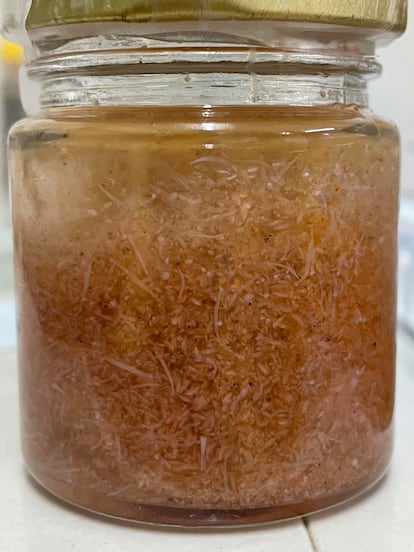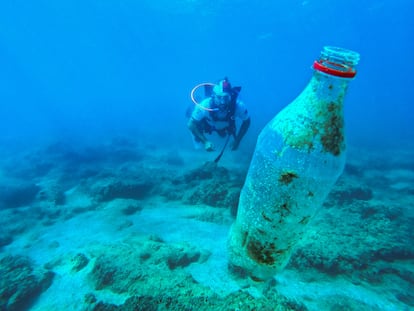In the Galápagos Islands, penguins are contaminated with microplastics
A study published in ‘PLOS One’ that various Ecuadorian scientists participated in warns of the high levels of contamination in the penguins’ ecosystem


An expedition was made to the Galápagos Islands in October 2021, when Covid-19 infection rates were still leading most of the headlines. Just as Charles Darwin did 186 years ago, five researchers arrived, among them members of the administration of the Galápagos National Park, scientists from the Escuela Superior Politécnica del Litoral de Ecuador (ESPOL), a major university in Guayaquil, and Ecuadorian biologist Juan José Alava, who works at the University of British Columbia (UBC), in Vancouver, Canada.
Despite hundreds of years worth of human visits, these islands remain a living laboratory, providing answers to many questions. In this case, the scientists had the mission of finding out whether the Galápagos penguins (Spheniscus mendiculus) were being affected by microplastics floating in the ecosystem. Globally, there are more than 170 trillion plastic particles afloat in the oceans.
Why were penguins the focus of the research investigation? “Because they’re what we call the ‘canary in the coal mine,’” Alava explains, referring to a common practice that British miners used in the 20th century. They would place a canary in a site that they wanted to dynamite, in order to tell if toxic gases were present. If the canary survived, they could enter the mine — if it died, they left the project alone.
Something similar occurs with the Galápagos penguins: being one of the highest steps of the local food chain, their health can also indicate how healthy — or how contaminated — the ecosystem is.
The problem, the researcher continues, is that “it’s not ethical to go and sacrifice a penguin.” These penguins — those who inhabit the Galápagos Islands — are rare. They’re a unique species, but they’re also endangered. It’s estimated that there are currently only around 1,200 left. They’re known to be the only tropical penguins in the world who can exist above the equator. Hence, what the scientists had to do instead was collect samples of everything around these birds to predict, through ecosystem-modeling, whether the bioaccumulation or biomagnification of microplastics was occurring in the penguins. And here, we have to pause, because there’s a difference. While bioaccumulation refers to the increase of microplastics in an organism through everything it’s exposed to in the ecosystem over time — not just its prey — biomagnification implies knowing how the contaminant is amplified in each organism or trophic level through the marine food web. The hypothesis, the study posits, is that “organisms at higher trophic levels — or apex predators — show higher concentrations [of microplastics], compared to organisms at lower trophic levels.”
The researchers worked on the archipelago for 15 days, moving between the most inhabited islands, such as Santa Cruz, and the almost pristine ones, such as Isabel. They collected samples of water, zooplankton, fish that the penguins eat, and two samples of their excrement. All of this work was done with permits issued by the Galápagos National Park, which protects the seabirds.
The idea as Alava explains was to use the data on microplastics that they found in each of these samples and then incorporate them into a complex modeling system. This wouldn’t just tell them if the microplastics were accumulating or how they were accumulating: it would allow the researchers to play with certain variables and scenarios, to understand how things would change for the fauna if there were more or fewer microplastics around the Galápagos.

Getting the results of the samples was an international effort. In the facilities of the Galápagos National Park, on the islands, the team filtered the water samples. In the Espol Ecotoxicology and Environmental Health Laboratory in Guayaquil, led by Paola Calle, another of the co-authors of the study, they processed the samples to remove organic material. Finally, at the Ocean Pollution Research Unit (OPRU) at UBC, where Alava is the principal researcher, the plastic particles were identified, in collaboration with the university’s Department of Chemistry. Karly McMullen, Félix Hernán Vargas, Omar Alvarado and Evgeny Pakhomov were the other researchers who participated in this process, which resulted in the publication in the journal PLOS One.
“The average concentration of microplastics observed in the water was 400 particles per cubic meter,” Alava explains. Most of these were fibers. “And, in a single specimen of a species of fish, the devil fish, or milkfish (Chanos chanos), 27 particles per fish were found.” In the other cases, the average was five particles per fish, as in mullets.
But this information was only the initial input that they used to feed the modeling system. How the second part of the investigation worked is perhaps the most difficult to explain. However, it could be summarized as follows: using an ecosystem-modeling software — Ecopath with Ecosim — they added not only the results of the samples, but also static data, such as the place where the ecosystem is located, along with the species’ matrix and their diet. This was also paired with a dynamic simulation component of the species or functional groups of the marine network, which vary over time (such as the trend in the biomass of the organisms). Then, through another tool called Ecotracer, the researchers were able to predict how microplastics accumulate through the food chain.
The model allowed them to play with four scenarios to see what would happen if certain variables were to be altered over time. “There was the standard scenario — the current one — which served as a reference baseline, with the average concentration observed (400 microplastics per cubic meter). But simulations were also made with a scenario with a high concentration of microplastics, a low concentration of microplastics, as well as another [hypothetical]: assuming that the elimination rate of microplastics in the penguins was 99%. That is, assuming that the microplastics don’t stay in the body, but rather are released,” Alava clarifies.
There were various conclusions. For instance, the team found that the increase in the accumulation of microplastics in organisms was constant, until approximately the fifth year of simulation, at which time the absorption rate began to gradually increase until, finally, becoming a plateau. As expected, the penguin also presented the highest level of microplastics per biomass, followed by barracuda, anchovy, sardine, herring, salema and predatory zooplankton. But the most important conclusion is emphasized by Alava: “The Galápagos penguins are facing major exposure to microplastics through their food chain.”

The experts predicted that they would detect a biomagnification of microplastic through the food chain. Hence, they were left with the additional task of investigating the role that the excretion rate plays in this issue… that is, how much plastic comes out through excrement, or how much remains in the digestive tract and tissues of penguins.
“The model predictions highlight that there’s a key knowledge gap in microplastic science, specifically in the accumulation behavior and residence time of microplastics in the intestine,” explains McMullen. She led the research as part of her master’s thesis at UBC. “Microplastics are becoming a major pollutant in the oceans; they enter the environment daily. So, there’s increasing concern for marine and coastal fauna and their food webs. For this reason, future research must address how these various plastics behave after ingestion.”
The important thing, as Alava notes, is that this information becomes a warning signal to take mitigation measures against plastics. Not only in the Galápagos — where single-use plastics have already been banned — but internationally. “Plastic pollution doesn’t respect any corner of the ocean and is [found] everywhere, from the Arctic to Antarctica.” And, although the Galápagos Islands are a milestone in the history of evolution and science, designated as a Natural World Heritage site and as a UNESCO Biosphere Reserve, they haven’t been immune to the floating plastic particles that seem to be everywhere.
Sign up for our weekly newsletter to get more English-language news coverage from EL PAÍS USA Edition
Tu suscripción se está usando en otro dispositivo
¿Quieres añadir otro usuario a tu suscripción?
Si continúas leyendo en este dispositivo, no se podrá leer en el otro.
FlechaTu suscripción se está usando en otro dispositivo y solo puedes acceder a EL PAÍS desde un dispositivo a la vez.
Si quieres compartir tu cuenta, cambia tu suscripción a la modalidad Premium, así podrás añadir otro usuario. Cada uno accederá con su propia cuenta de email, lo que os permitirá personalizar vuestra experiencia en EL PAÍS.
¿Tienes una suscripción de empresa? Accede aquí para contratar más cuentas.
En el caso de no saber quién está usando tu cuenta, te recomendamos cambiar tu contraseña aquí.
Si decides continuar compartiendo tu cuenta, este mensaje se mostrará en tu dispositivo y en el de la otra persona que está usando tu cuenta de forma indefinida, afectando a tu experiencia de lectura. Puedes consultar aquí los términos y condiciones de la suscripción digital.










































